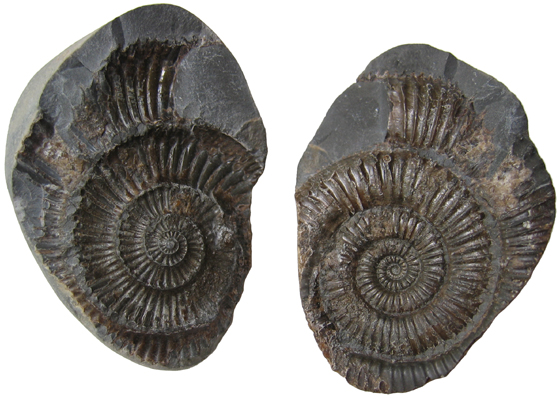
Cast fossils may also be endocasts of the. Common minerals include silicate carbonate and pyrite.

Broadly speaking the.
Molds and casts fossils. Casts and molds are types of fossilization where the physical characteristics of organisms are impressed onto rocks especially coarse porous rocks such as sandstones. Typically the hard parts of an organism shells of mollusks skeletal structures of coelenterates bones and teeth of vertebrate chitinous exoskeleton of arthropods trunks of trees and many sphenophyte leave the best. Cast fossils are very similar to mold fossils.
Like mold fossils they form and are imprinted within a type of substrate. However instead of being hollow minerals rocks or other materials have filled in the gaps for a more solid fossil. Like mold fossils cast fossils are commonly skin claws teeth leaves and embryos.
Two main types of fossils are molds and casts. We find molds where an animal or plant was buried in mud or soft soil and decayed away leaving behind an impression of their bodies leaves or flowers. Casts are formed when these impressions are filled with other types of sediment that form rocks which take the place of the animal or plant.
The formation of fossil molds and casts parallels the method by which a sculptor creates a bronze statue. The sculptor does not carve directly on a block of bronze but creates a sculpture with some other medium wood or wax perhaps. A mold is then constructed around the original sculpture and when the mold is complete the original is removed in some fashion disassembling the mold temporarily or.
When Fossil molds are found they can be filled and used to make many copies of the fossil. FOSSIL CASTS are found when a fossil mold underground is filled with sediment to form a fossil in the actual shape of the animal bones. Instead of being made of actual bone fossil casts are made of hardened sediment rock.
Mold And Cast Fossils. Mold fossils are indentations of a dead organism left behind in a rock. When these molds fill they are called cast fossils.
Cast fossils may also be endocasts of the. Fossil trees including tree casts and tree moulds probably form on most volcanoes where fluidic basaltic eruptions inundate woodlands and forests but their preservation into the geological record as tree moulds and casts within ancient lava fields is relatively uncommon. This is due to the complex sequence of factors involved and the sequence of events required.
Broadly speaking the. The definitions of molds and casts were made very simply at the beginning of this thread and thats really all you need. Molds are made from originals casts are made from molds.
Its that simple as I see it. I suggest that you take trace fossils out of this moldcast realm. Trace fossils are a whole different bag of worms.
It would be. There are many processes that lead to fossilization including permineralization casts and molds authigenic mineralization replacement and recrystallization adpression carbonization and bioimmuration. Fossils vary in size from one- micrometre 1 µm bacteria to dinosaurs and trees many meters long and weighing many tons.
Casts and molds A cast or a mold fossil is an impression of a living organism. They are made when an organism dissolves in the Earth and leaves a hollow mold behind. The mold is then filled in by minerals leaving something like a statue of the organism behind.
Common minerals include silicate carbonate and pyrite. This project was created with Explain Everything Interactive Whiteboard for iPad. If you dont have fossils or animal bones in your backyard or just want to learn about how mold and cast fossils are made we can use our fossil salt playdough.
Making mold and cast fossils. The hardest part of making mold and cast fossils is deciding what to use to make the first mold. The options are endless.
Local seashells barnacles or dead crab legs are a fun natural idea. Mold is the replica of the internal details of the structure of an old living organism leaving them in the sedimentary rocks after death such as Ammonites fossils. Traces that indicate activity of an old living organism leaving them in sedimentary rocks during its life.
Such as Dinosaurs footprint. Casts and molds - A cast or a mold fossil is an impression of a living organism. They are made when an organism dissolves in the Earth and leaves a hollow mold behind.
The mold is then filled in by minerals leaving something like a statue of the organism behind. Freezing - Some fossils are preserved in ice. As long as the ice doesnt melt the fossil may be preserved for thousands of years.
This next picture shows the external mold of the original specimen and to the right an external cast of this mold. Most collectors commonly do not bother to collect external molds. At some localities however that is all you can find and if you need to identify the genus and species it will help if you create a latex external cast of the external mold.
That way you can make a positive. EpicScience - Cast and Mold Fossils - YouTube After studying fossils in our fourth grade class students were able to use clay and plaster to create their own cast and mold seashell fossils.